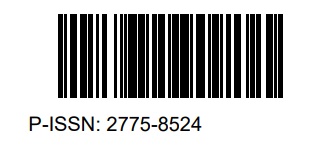Error Analysis on the Students Pronunciation of Affricates Sounds at SMA Negeri 10 Medan
DOI:
https://doi.org/10.33477/lingue.v1i2.1206Abstract
Abstract This article deal with error analysis on the students’ pronunciation of affricates sounds. The method of research applied was descriptive quantitative method. It was applied to find and to analyze error analysis on the students’ pronunciation of affricates sounds. The population of this research was the first year students of SMA NEGERI 10 MEDAN at Jl.Tilak Medan. There were 47 students in parallel classes and all of them were taken as the sample. The instrument of the research was administrated test. The test was teacher made test. There were 20 items were given to the students. The test results were analyzed by finding out the percentages of students’ error in pronunciation affricates sounds. The total correct answer of the test were 437 or 9,340% and incorrect answer were 407 or 8,659 % .There were 3 causes of errors analysis on the students’ pronunciation of affricates sounds, they were intralingual, interlingual, and carelessness.There were 44 or 10, 09% for intralingual errors, 98 or 22,47% for interlingual errors and 295 or 67,50 % for carelessness errors. Keywords:Affricates, Eror,Causes. Abstrak Artikel ini membahas analisis kesalahan pelafalan bunyi afrikat pada siswa. Metode penelitian yang digunakan adalah metode deskriptif kuantitatif. Itu diterapkan untuk menemukan dan menganalisis analisis kesalahan pada pelafalan bunyi afrikat siswa. Populasi penelitian ini adalah siswa tahun pertama SMA Negeri 10 Medan di jalan.Tilak Medan yang terdiri dari 47 siswa di kelas paralel dan semuanya diambil sebagai sampel. Instrumen penelitian adalah tes administrasi. Tes adalah tes yang dibuat guru. Ada 20 item yang diberikan kepada siswa. Kemudian jawaban dianalisis dengan mencari tahu persentase kesalahan siswa dalam pelafalan melafalkan bunyi untuk menunjukkan bahwa total jawaban yang benar dari tes adalah 437 atau persentase 9,340% dan jawaban yang salah adalah 407 atau persentase 8,659% ada 3 penyebab analisis kesalahan pada pengucapan bunyi afrikat siswa, itu adalah intralingual, interlingual, dan kecerobohan. Untuk kesalahan intralingual adalah 44 atau 10, 09%, untuk kesalahan interlingual adalah 98 atau 22,47% dan untuk kesalahan kecerobohan adalah 295 atau 67,50%. Kata Kunci: Afrikat, Kesalahan, Penyebab.References
Arikunto. S. 2006. Procedure Penelitian suatu pendekatan praktik. Jakarta: Rineka Cipta Press
Boey, Lim Kiat. 1989. An Introduction to linguistic for Language Teaching Singapore : University of Singapore Press Center.
Brown, H.D. 1980. Principles of language learning and teaching. New Jersey: practice hall.
Conning, Swaorth. 1984. Education and Selecting EFL Teaching Material: London Helmen
Corder, S.P. 1981. Errors analysis and interlanguage. Oxford: oxford university press.
Jhones. 1977. English consonant for Teaching material. Melbourn: London University Newyork.
Jones, D. 1972. An Outlineof English Phonetics. Cambridge : Cambridge University.
Norrish, J. 1983. Language Learners and Their Error, New York London: Macimilan Press
Richards, JC. 1981. Error Analysis and Second Language Acquistion. Cambridge: Cambridge University Press
Sembiring, Novalina. 2016. An Analysis of Pronunciation Errors Made by the Fourth Semester Students of English Education Study Program at UNIKA.Sumatera Utara. JURNAL Suluh Pendidikan FKIP-UNH.
Ubol. Little Wood. 1989. Foreign an Second Language Leaarning. New York : Cambridge
Verma. S.K. 1989. The Pronunciation of English. Melbourne: London University New York
Downloads
Published
How to Cite
Issue
Section
License
If accepted for publication, the copyright of the article belongs to the author. Copyright includes the exclusive right to reproduce or transmit manuscripts in any form and media: reprint, produce photographs, microfilm, or translated versions of the manuscript. Increasing parts of this journal, storage and transmission of databases of any form or media, such as electronic copies, electrostatic and mechanical copies, photocopies, recordings, magnetic media and so on are permitted without permission. LINGUE: Jurnal Bahasa, Budaya dan Sastra, allow readers to read, download, copy, distribute, print, search, or link the fulltext of its articles and allow readers to use them for any other lawful purpose. However, it can not be used for commercial purposes
Jika diterima untuk publikasi, hak cipta artikel adalah milik penulis. Hak Cipta mencakup hak eksklusif untuk mereproduksi atau mengirimkan manuskrip dalam bentuk dan media apa pun: mencetak ulang, menghasilkan foto, mikrofilm, atau versi terjemahan dari manuskrip tersebut. Memperbanyak bagian jurnal ini, penyimpanan dan transmisi database dalam bentuk atau media apa pun, seperti salinan elektronik, salinan elektrostatis dan mekanis, fotokopi, rekaman, media magnetis, dan sebagainya diizinkan tanpa izin. LINGUE: Jurnal Bahasa,Budaya dan Sastra, memungkinkan pembaca untuk membaca, mengunduh, menyalin, mendistribusikan, mencetak, mencari, atau menautkan teks lengkap artikelnya dan memungkinkan pembaca untuk menggunakannya untuk tujuan yang sah lainnya. Namun, tidak dapat digunakan untuk tujuan komersial

LINGUE : Jurnal Bahasa, Budaya, dan Sastra Ciptaan disebarluaskan di bawah Lisensi Creative Commons Atribusi-TanpaTurunan 4.0 Internasional.







